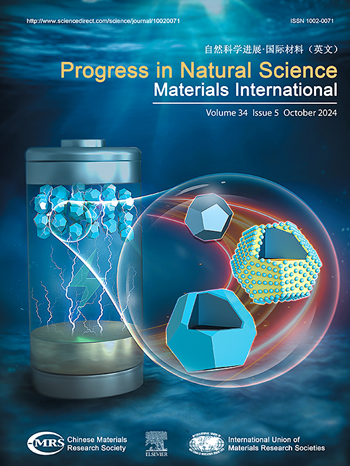用于人工突触的渐进式电导调谐mxene -碳量子点混合忆阻器
IF 7.1
2区 材料科学
Q2 MATERIALS SCIENCE, MULTIDISCIPLINARY
Progress in Natural Science: Materials International
Pub Date : 2025-06-01
DOI:10.1016/j.pnsc.2025.03.001
引用次数: 0
摘要
MXenes是新兴的二维(2D)纳米材料,由过渡金属碳化物/氮化物/碳氮化物的多个原子层组成。然而,由于金属的类似导电性,限制了其在电子器件中的内在应用。在这项工作中,发现MXene的直接表面修饰有望将其功能扩展到半导体领域。设计并采用零维碳量子点(0D-CDs)实现MXene的表面改性。均匀分布的cd被引入作为电荷存储元件,从而增强电荷传输过程,降低功耗,提高基于mxene的电子器件的稳定性。值得注意的是,cd修饰的MXene忆阻器表现出出色的双向可调忆阻性能,并复制了突触的可塑性行为,从而促进了电子突触的发展。该研究揭示了通过CDs调制策略将MXene应用于高性能忆阻器的潜力,并为将金属导电二维纳米材料扩展到非易失性存储器和人工突触提供了有效途径。本文章由计算机程序翻译,如有差异,请以英文原文为准。

MXene-carbon quantum dot hybrid memristor with progressive conductance tuning for artificial synaptic application
MXenes are emerging two-dimensional (2D) nanomaterials comprising multiple atomic layers of transition metal carbides/nitrides/carbonitrides. However, due to the metallic analogous conductivity, their intrinsic application in electronic devices is restricted. In this work, it is discovered that the straightforward surface modification of MXene holds promise for extending its functionality into the semiconductor field. The zero-dimensional carbon quantum dots (0D-CDs) are designed and adopted to allow the surface modification of MXene. The uniformly distributed CDs are introduced to function as charge storage elements, thereby enhancing charge transport process, reducing power consumption, and improving stability of MXene-based electronics. Notably, the CDs-modified MXene memristor exhibits outstanding bidirectional tunable memristive performance and replicates synaptic plasticity behavior, which facilitates the development of electronic synapses. This study unveils the potential of applying MXene for high-performance memristors through CDs modulation strategy, and provides an effective pathway for expanding the metallic conductive 2D nanomaterials into non-volatile memory and artificial synapses.
求助全文
通过发布文献求助,成功后即可免费获取论文全文。
去求助
来源期刊
CiteScore
8.60
自引率
2.10%
发文量
2812
审稿时长
49 days
期刊介绍:
Progress in Natural Science: Materials International provides scientists and engineers throughout the world with a central vehicle for the exchange and dissemination of basic theoretical studies and applied research of advanced materials. The emphasis is placed on original research, both analytical and experimental, which is of permanent interest to engineers and scientists, covering all aspects of new materials and technologies, such as, energy and environmental materials; advanced structural materials; advanced transportation materials, functional and electronic materials; nano-scale and amorphous materials; health and biological materials; materials modeling and simulation; materials characterization; and so on. The latest research achievements and innovative papers in basic theoretical studies and applied research of material science will be carefully selected and promptly reported. Thus, the aim of this Journal is to serve the global materials science and technology community with the latest research findings.
As a service to readers, an international bibliography of recent publications in advanced materials is published bimonthly.

 求助内容:
求助内容: 应助结果提醒方式:
应助结果提醒方式:


